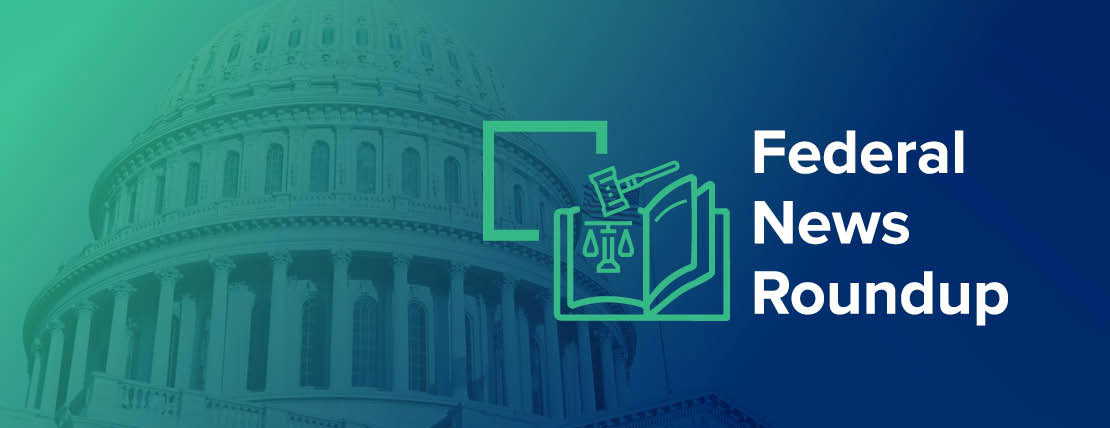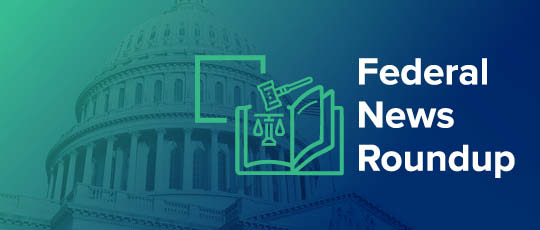- Justice Roberts Stays Appellate Decision on Agency Board Firings
- Another Fired Agency Leader Sues the President
- Trump Renominates Lucas to Chair EEOC
- Bill Seeks to Reverse DOL Guidance on Crypto as 401(k) Option
- DOL Shares SECURE 2.0 Guidance, as AFN Deadline Approaches
- Congressman Asks DOL to Pull Fiduciary Final Rule
- Amid Trump Changes, Most Orgs Holding Firm to Social Responsibility
Justice Roberts Stays Appellate Decision on Agency Board Firings
The question of whether a U.S. president has the authority to remove federal agency board members at will continued to play out in the courts this week.
On Monday, April 7, the U.S. Court of Appeals for the District of Columbia Circuit, in a 7-4 decision, ruled President Donald Trump’s firings of National Labor Relations Board (NLRB) member Gwynne Wilcox and Merit Systems Protection Board (MSPB) member Cathy Harris were unlawful. All seven members of the majority were appointed by Democratic presidents. The four dissenters are Republican appointees, including three named by Trump in his first term.
That ruling enabled Wilcox and Harris to return to their board posts … for less than two days.
That’s because on Wednesday afternoon, April 9, U.S. Supreme Court Chief Justice John Roberts stayed that appellate court order, putting the case firmly in the hands of the nation’s highest court.
The ability of a president to fire members of federal agencies has great impact on HR and total rewards professionals since many of these bodies — including the NLRB, Equal Employment Opportunity Commission, Securities and Exchange Commission, Social Security Administration, and Pension Benefit Guaranty Corporation — oversee critical aspects of work, the workforce and the workplace.
Of the two agencies at the heart of this week’s court decisions, the NLRB is the more important for Workspan Daily readers since it enforces the National Labor Relations Act (NLRA), conducts elections to determine union representation and investigates unfair labor practice allegations related to wages, pay rates, working hours, work conditions, etc. (The MSPB oversees federal merit systems and protects federal employees against work abuses by agency management.)
This April 7 appellate court decision had reversed a March 28 decision by a three-judge panel on the same circuit court, which upheld the president’s right to at-will firing and kept the plaintiffs out of their jobs while the case proceeded.
In the April 7 court order, the majority wrote in an unsigned opinion: “The Supreme Court has repeatedly told the courts of appeals to follow extant Supreme Court precedent unless and until that Court itself changes it or overturns it. If a precedent of the Supreme Court ‘has direct application in a case,’ lower courts ‘should follow the case which directly controls,’ leaving to the Supreme Court ‘the prerogative of overruling its own decisions.’”
The April 7 ruling temporarily put the NLRB back to three active members (the board traditionally has five), which gave it a quorum and allowed it to resume operations.
Justice Roberts’ April 9 stay order halted the NLRB again and put the Supreme Court in charge of deciding the matter, which was a major goal of the Trump administration.
Roberts said his order will last until either he or the full court issues a longer-term decision.
At ultimate stake here is the continued viability of the Supreme Court’s 1935 Humphrey’s Executor precedent, which made it illegal to fire workers from independent government agencies without cause. Trump and his legal team have built the case that such shields are an unconstitutional limit on a president’s power.
Another Fired Agency Leader Sues the President
In a related story on the president’s termination power, fired Equal Employment Opportunity Commission (EEOC) member Jocelyn Samuels filed a lawsuit against the Trump administration on April 9, claiming her ouster was unlawful and politically motivated. Samuels and fellow Democratic commissioner Charlotte Burrows were removed from their roles on Jan. 27.
The EEOC, created under Title VII of the Civil Rights Act of 1964, typically has five members and is tasked with protecting workers and job applicants from discrimination on the basis of race, color, religion, sex and national origin. The law staggers commissioners’ five-year terms so the president may annually appoint a new member. No more than three of the five commissioners may be from the same political party.
No president had ever removed an EEOC commissioner from office, and the firings by Trump left the agency, which already had a vacancy, without a three-member quorum.
“Trump’s efforts to hamstring the EEOC are consistent with and further his administration’s efforts to turn back the clock on decades of established precedent protecting workers and job applicants from discrimination, but they are contrary to law,” Samuels said in her lawsuit.
The Roberts stay order on the Wilcox/Harris case is likely to impact this lawsuit.
Trump Renominates Lucas to Chair EEOC
In related EEOC news, President Trump renominated Andrea Lucas, the agency’s acting chair, to a new five-year term expiring July 1, 2030. Trump had installed her as acting chair in January, with a term set to expire on July 1.
Lucas said in a press release that, if confirmed by the Senate, she would “further our work of restoring evenhanded enforcement of employment civil rights laws for all Americans. Part of that work is simply clarifying longstanding civil rights rules that have been obscured by unequal enforcement in recent years.”
Since taking leadership of the commission, Lucas has sought to roll back inclusivity initiatives created during the administration of President Joe Biden and “defend the biological and binary reality of sex and related rights.” She has pledged to mobilize President Trump’s offensive against private-sector employers’ diversity, equity and inclusion programs.
Bill Seeks to Reverse DOL Guidance on Crypto as 401(k) Option
Sen. Tommy Tuberville (R-Alabama) and Rep. Byron Donalds (R-Florida) on Tuesday, April 8, reintroduced the Financial Freedom Act in Congress. The Senate/House bill aims to prohibit the Secretary of Labor from restricting the available investments in self-directed 401(k)s. More specifically, it seeks to reverse guidance issued by the Department of Labor’s Employee Benefits Security Administration (EBSA) in 2022 that dissuades retirement plans from including cryptocurrency or other alternative investments in their offerings.
According to language in the bill, the DOL should be prevented from “[requiring] a fiduciary to select, or [prohibiting] a fiduciary from selecting, any particular type of investment alternative, provided that a fiduciary provides the participant or beneficiary an opportunity to choose, from a broad range of investment alternatives, the manner in which some or all of the assets of the participant’s or beneficiary’s account are invested, according to regulations prescribed by the Secretary.”
The House version of the bill was referred to the House Committee on Education and Workforce, and the Senate version was referred to the Senate Committee on Health, Education, Labor and Pensions.
DOL Shares SECURE 2.0 Guidance, as AFN Deadline Approaches
In other retirement benefit news, the DOL released a field assistance bulletin on April 3 that outlines how pension plans should annually calculate and disclose asset and liability values under new SECURE 2.0 Act requirements.
SECURE 2.0 brought about numerous changes for retirement plans, including updated disclosure requirements for defined benefit plan annual funding notices (AFNs) for all plan years, starting Jan. 1, 2024. For entities with calendar-year plans, the first AFN due date for incorporating the revised requirements is April 30, 2025.
Before SECURE 2.0, AFNs generally had to contain plan information about funded status, investment policies, regulatory filings, participant demographics and more. Though the purpose of AFNs remains the same — keeping participants, beneficiaries and the Pension Benefit Guaranty Corporation (PBGC) informed — the DOL document outlined requirement changes for funded status, demographic information, funding policy and PBGC guarantees.
Congressman Asks DOL to Pull Fiduciary Final Rule
In other DOL news, Tim Walberg, a Republican Congressman from Michigan, called on Secretary of Labor Lori Chavez-DeRemer to “rescind or withdraw” the agency’s fiduciary rule, which was finalized on April 25, 2024, by previous secretary Julie Su, and took effect Sept. 23, 2024.
In a letter to Chavez-DeRemer, Walberg, who chairs the House of Representatives Committee on Education and Workforce, stated, “I encourage [the] DOL to enforce its laws while providing robust compliance assistance to workers and businesses instead of continuing the enforcement-only approach taken by the Biden-Harris administration.”
The Retirement Security Rule was updated to expand the definition of an investment advice fiduciary under the Employee Retirement Income Security Act (ERISA). It aimed to ensure that financial advisors act in the best interests of retirement savers.
The updated definition clarifies that HR professionals who conduct typical retirement plan work are not acting as fiduciaries. The rule expands the definition of a fiduciary to include those who, in certain cases, provide financial advice on a one-time basis. It also sets forth the standards of service that fiduciaries must provide.
Amid Trump Changes, Most Orgs Holding Firm to Social Responsibility
Amid the ongoing debate regarding the role employers should play in shaping American society, a new pulse survey released March 27 by the Association of Corporate Citizenship Professionals (ACCP) provides insights on the anticipated effect the Trump administration will have on corporate social impact programs and initiatives at leading companies, as well as what areas of this work will most likely be affected.
The survey of 141 corporate social impact leaders found 90% of respondents anticipate their organization’s commitment to corporate social responsibility (CSR) will either stay the same (77%) or increase (13%) under the new administration. When asked about the anticipated impacts of the administration on their CSR programs, the top responses included:
- A shift in message and communications. Fifty-three percent of respondents cited a “change in language describing the work” as the top way they anticipate their work being impacted. In addition, 31% cited a likely “decrease in external communications about the work.”
- More legal oversight. Thirty percent of respondents said they anticipate an increase in legal examination and direction of their work.
The survey also examined how corporate commitments to diversity, equity and inclusion (DEI) and environmental, social and governance (ESG) may change during the Trump presidency. Not surprisingly, the most profound impact is expected to be around DEI initiatives. That said, most respondents expect their organization’s commitment to ESG (82%) and DEI (69%) to either remain steady or increase under the new administration.
Editor’s Note: Additional Content
For more information and resources related to this article, see the pages below, which offer quick access to all WorldatWork content on these topics:







